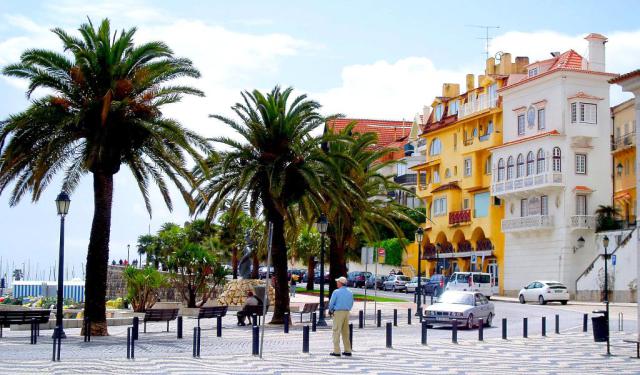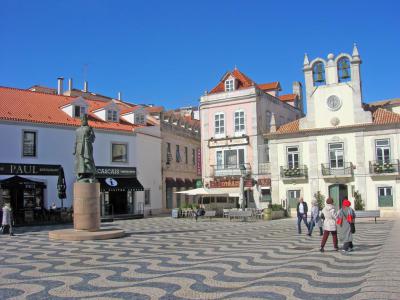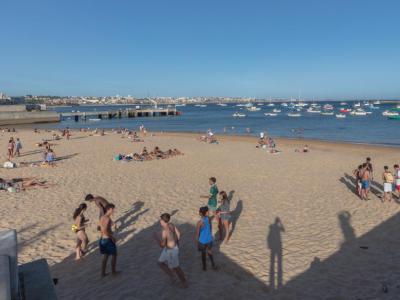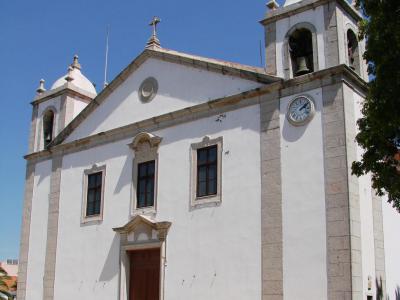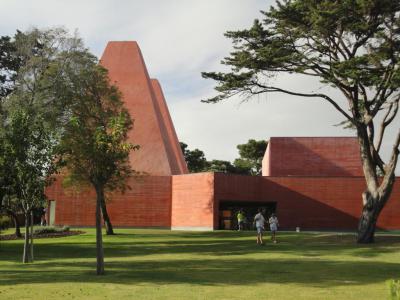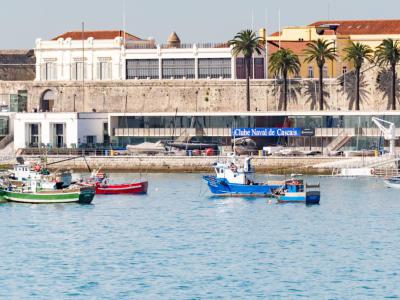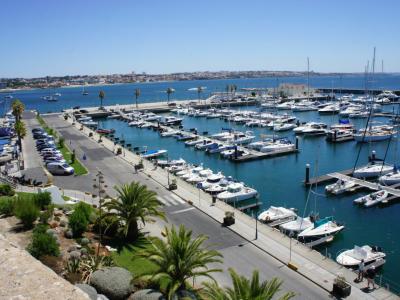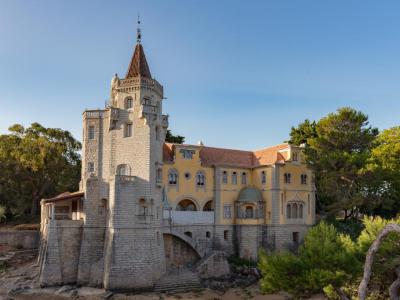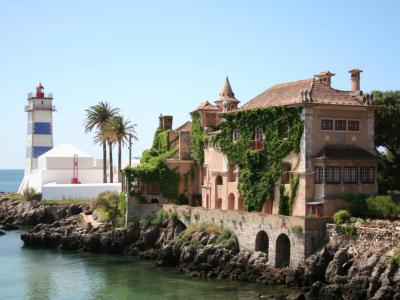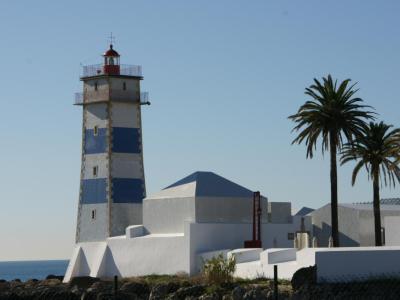Cascais Introduction Walking Tour (Self Guided), Cascais
A charming seaside town some 30 minutes' drive away from the capital of Portugal, Cascais, holds a unique place in the country's history and culture. It started life as a humble fishing village, with the Romans, Visigoths, and Muslims leaving their mark on the area. Records dating back to Roman times suggest that it served as a stopover point for travelers along the coastline.
The name "Cascais" is believed to have derived from a plural derivation of cascal (monte de cascas) which means a "mountain of shells," reflecting the abundant volume of marine mollusks harvested from the coastal waters.
Cascais began to develop in the 12th century, initially under the administrative authority of Sintra. It thrived on fishing, maritime trade, and agriculture, notably supplying fish to Lisbon. In 1364, Cascais gained the town status.
Following the restoration of Portugal as an independent kingdom from Spain, in 1640, the town's medieval fortress was expanded with new defensive structures, including the Citadel of Cascais.
Cascais gained prominence in the late 19th century when it became a popular retreat for the Portuguese nobility and artistic elite, and ultimately, as a royal summer residence. The town witnessed significant development during this period, including the construction of grand villas and the expansion of its waterfront. King Luís I introduced electric lights in 1878 and invested in infrastructure, railways, and cultural amenities. During World War II, Cascais also served as a haven for exiled European royalty.
Today, Cascais is a seaside perfection and a top holiday destination on the Lisbon coastline. It may be small in size, but there are many epic things to do here.
Stroll along the Cascais Marina and watch the boats bob in the harbor. It is also a great place for a waterfront meal or to simply enjoy the scenic views.
The Condes de Castro Guimarães Museum, housed in a picturesque palace, features a diverse collection of artifacts, offering insights into Cascais' cultural heritage.
Meanwhile, perched on the coastline, the Santa Marta Lighthouse offers panoramic views of the Atlantic Ocean and provides a glimpse into the maritime history of Cascais.
It is no secret that Cascais makes one of the best day trips from Lisbon. So, whenever you are in the capital, pack your bags and embark on a journey to discover the magic of this picturesque place. Experience the warmth of its people, savor the local cuisine, and make memories that will last a lifetime in the enchanting town of Cascais.
The name "Cascais" is believed to have derived from a plural derivation of cascal (monte de cascas) which means a "mountain of shells," reflecting the abundant volume of marine mollusks harvested from the coastal waters.
Cascais began to develop in the 12th century, initially under the administrative authority of Sintra. It thrived on fishing, maritime trade, and agriculture, notably supplying fish to Lisbon. In 1364, Cascais gained the town status.
Following the restoration of Portugal as an independent kingdom from Spain, in 1640, the town's medieval fortress was expanded with new defensive structures, including the Citadel of Cascais.
Cascais gained prominence in the late 19th century when it became a popular retreat for the Portuguese nobility and artistic elite, and ultimately, as a royal summer residence. The town witnessed significant development during this period, including the construction of grand villas and the expansion of its waterfront. King Luís I introduced electric lights in 1878 and invested in infrastructure, railways, and cultural amenities. During World War II, Cascais also served as a haven for exiled European royalty.
Today, Cascais is a seaside perfection and a top holiday destination on the Lisbon coastline. It may be small in size, but there are many epic things to do here.
Stroll along the Cascais Marina and watch the boats bob in the harbor. It is also a great place for a waterfront meal or to simply enjoy the scenic views.
The Condes de Castro Guimarães Museum, housed in a picturesque palace, features a diverse collection of artifacts, offering insights into Cascais' cultural heritage.
Meanwhile, perched on the coastline, the Santa Marta Lighthouse offers panoramic views of the Atlantic Ocean and provides a glimpse into the maritime history of Cascais.
It is no secret that Cascais makes one of the best day trips from Lisbon. So, whenever you are in the capital, pack your bags and embark on a journey to discover the magic of this picturesque place. Experience the warmth of its people, savor the local cuisine, and make memories that will last a lifetime in the enchanting town of Cascais.
How it works: Download the app "GPSmyCity: Walks in 1K+ Cities" from Apple App Store or Google Play Store to your mobile phone or tablet. The app turns your mobile device into a personal tour guide and its built-in GPS navigation functions guide you from one tour stop to next. The app works offline, so no data plan is needed when traveling abroad.
Cascais Introduction Walking Tour Map
Guide Name: Cascais Introduction Walking Tour
Guide Location: Portugal » Cascais (See other walking tours in Cascais)
Guide Type: Self-guided Walking Tour (Sightseeing)
# of Attractions: 9
Tour Duration: 2 Hour(s)
Travel Distance: 2.4 Km or 1.5 Miles
Author: DanaOffice
Sight(s) Featured in This Guide:
Guide Location: Portugal » Cascais (See other walking tours in Cascais)
Guide Type: Self-guided Walking Tour (Sightseeing)
# of Attractions: 9
Tour Duration: 2 Hour(s)
Travel Distance: 2.4 Km or 1.5 Miles
Author: DanaOffice
Sight(s) Featured in This Guide:
- Praça 5 de Outubro (5th of October Square)
- Ribeira Beach
- Church of Our Lady of the Assumption
- House of Stories Paula Rego
- Citadel of Cascais
- Cascais Marina
- Condes de Castro Guimarães Museum
- Casa de Santa Maria (House of Saint Mary)
- Santa Marta Lighthouse
1) Praça 5 de Outubro (5th of October Square)
5th of October Square, located in the charming town of Cascais, Portugal, holds a rich history that reflects the transformation of this former fishing village into a cosmopolitan resort destination.
Cascais first gained recognition as a resort for Portugal's royal family during the late 19th and early 20th centuries. Over time, the citadel of Cascais began to deteriorate until King Luiz I decided to embark on a restoration project. His vision was to turn Cascais into his summer residence, ultimately elevating the quiet fishing village into a vibrant and sophisticated address.
The square's name, 5th of October Square, commemorates the day of the revolution in 1910 when the last King of Portugal was overthrown, marking a significant turning point in the nation's history. This area is an integral part of downtown Cascais, characterized by its well-organized pedestrian zones.
At the heart of the square stands a monument dedicated to King Dom Pedro, known as "the Liberator." Dom Pedro played a pivotal role in history as the founder and first ruler of the Empire of Brazil. During the French invasion of Portugal in 1807, he and his family fled the country, marking a period of significant change. Another smaller monument in the square pays homage to King Luiz I, who passed away in Cascais in 1889. This monument was erected in 1989 to commemorate the centenary of his death.
The Town Hall, adorned with beautiful azulejos (traditional Portuguese ceramic tiles), features depictions of Catholic saints, adding to the square's character and charm. Additionally, there is an azulejos panorama that showcases the square's historical significance.
The iconic peleorinho column, found on public squares throughout Portugal, further adds to the square's cultural significance.
Cascais first gained recognition as a resort for Portugal's royal family during the late 19th and early 20th centuries. Over time, the citadel of Cascais began to deteriorate until King Luiz I decided to embark on a restoration project. His vision was to turn Cascais into his summer residence, ultimately elevating the quiet fishing village into a vibrant and sophisticated address.
The square's name, 5th of October Square, commemorates the day of the revolution in 1910 when the last King of Portugal was overthrown, marking a significant turning point in the nation's history. This area is an integral part of downtown Cascais, characterized by its well-organized pedestrian zones.
At the heart of the square stands a monument dedicated to King Dom Pedro, known as "the Liberator." Dom Pedro played a pivotal role in history as the founder and first ruler of the Empire of Brazil. During the French invasion of Portugal in 1807, he and his family fled the country, marking a period of significant change. Another smaller monument in the square pays homage to King Luiz I, who passed away in Cascais in 1889. This monument was erected in 1989 to commemorate the centenary of his death.
The Town Hall, adorned with beautiful azulejos (traditional Portuguese ceramic tiles), features depictions of Catholic saints, adding to the square's character and charm. Additionally, there is an azulejos panorama that showcases the square's historical significance.
The iconic peleorinho column, found on public squares throughout Portugal, further adds to the square's cultural significance.
2) Ribeira Beach
Ribeira Beach is the beach closest to the historic square and old town of Cascais. This charming beach exudes a lively atmosphere, with plenty of activities to keep visitors engaged.
One of the distinctive features of Ribeira Beach is its bustling scene of small boats being launched and landed in the shallow waters of Cascais Bay. The waters at Ribeira Beach are notably calm, thanks to the natural shelter provided by a large breakwater.
Backing onto Cascais' historic old town and framed by some of the town's elegant villas, Ribeira Beach offers a picturesque setting. It's an ideal spot to unwind, people-watch, and take in the beauty of the surroundings.
During the summer months, the esplanade behind the beach comes alive with various events and activities. Visitors can enjoy regular craft fairs, featuring a diverse range of goods, from traditional Portuguese products to unique African handcrafted items. These fairs add an extra layer of vibrancy to the beach area, making it an appealing destination for both relaxation and cultural exploration.
While Ribeira Beach may not be the largest beach in Cascais, its proximity to the old town, lively atmosphere, and seasonal events make it a popular choice for locals and tourists alike.
One of the distinctive features of Ribeira Beach is its bustling scene of small boats being launched and landed in the shallow waters of Cascais Bay. The waters at Ribeira Beach are notably calm, thanks to the natural shelter provided by a large breakwater.
Backing onto Cascais' historic old town and framed by some of the town's elegant villas, Ribeira Beach offers a picturesque setting. It's an ideal spot to unwind, people-watch, and take in the beauty of the surroundings.
During the summer months, the esplanade behind the beach comes alive with various events and activities. Visitors can enjoy regular craft fairs, featuring a diverse range of goods, from traditional Portuguese products to unique African handcrafted items. These fairs add an extra layer of vibrancy to the beach area, making it an appealing destination for both relaxation and cultural exploration.
While Ribeira Beach may not be the largest beach in Cascais, its proximity to the old town, lively atmosphere, and seasonal events make it a popular choice for locals and tourists alike.
3) Church of Our Lady of the Assumption
The Church of Our Lady of the Assumption is a historical and venerable religious edifice. This sacred place holds a significant historical presence, with records of its existence dating as far back as 1572, as evidenced by its mention in the engraving of Cascais found in the work "Civitates Orbis Terrarum."
In 1671, the church underwent extensive restoration and improvement works, during which the religious activities temporarily relocated to the Socorro chapel, a predecessor to the present-day Church of Navegantes. After the successful completion of these restoration efforts, the temple was once again opened to the public on December 21, 1681.
The devastating earthquake of 1755 inflicted substantial damage to the church, particularly affecting the facade and the high choir, rendering the church unusable. Consequently, religious ceremonies moved to the chapel of Nossa Senhora da Nazaré, situated in the former Casa dos Falcões. This period of disrepair and upheaval led to the fusion of the two pre-existing parishes, creating a single parish named the Parish of Nossa Senhora da Assunção and Ressurreição.
Over the centuries, restoration works on the church continued, with the most recent campaign occurring during the 2009-2010 biennium. To commemorate these efforts, a sculpture of Pope John Paul II, designed by Alves André, was unveiled on May 15, 2010, in Largo near the church.
Architecturally, the Church of Our Lady of the Assumption follows a longitudinal plan with elegant and unassuming lines. The west-facing main facade comprises three distinct sections, separated by sturdy stone pilasters. Flanking the facade are two square bell towers, each capped with a pyramidal roof.
Upon entering the church, visitors are greeted by a spacious and luminous interior adorned with a rich array of decorative elements, harmoniously blending tile coverings, gilded woodwork, and intricate paintings.
The church's nave boasts a barrel-vaulted roof adorned with a central medallion painting depicting the Assumption of Our Lady, a masterpiece by José Malhoa from the early 20th century.
In 1671, the church underwent extensive restoration and improvement works, during which the religious activities temporarily relocated to the Socorro chapel, a predecessor to the present-day Church of Navegantes. After the successful completion of these restoration efforts, the temple was once again opened to the public on December 21, 1681.
The devastating earthquake of 1755 inflicted substantial damage to the church, particularly affecting the facade and the high choir, rendering the church unusable. Consequently, religious ceremonies moved to the chapel of Nossa Senhora da Nazaré, situated in the former Casa dos Falcões. This period of disrepair and upheaval led to the fusion of the two pre-existing parishes, creating a single parish named the Parish of Nossa Senhora da Assunção and Ressurreição.
Over the centuries, restoration works on the church continued, with the most recent campaign occurring during the 2009-2010 biennium. To commemorate these efforts, a sculpture of Pope John Paul II, designed by Alves André, was unveiled on May 15, 2010, in Largo near the church.
Architecturally, the Church of Our Lady of the Assumption follows a longitudinal plan with elegant and unassuming lines. The west-facing main facade comprises three distinct sections, separated by sturdy stone pilasters. Flanking the facade are two square bell towers, each capped with a pyramidal roof.
Upon entering the church, visitors are greeted by a spacious and luminous interior adorned with a rich array of decorative elements, harmoniously blending tile coverings, gilded woodwork, and intricate paintings.
The church's nave boasts a barrel-vaulted roof adorned with a central medallion painting depicting the Assumption of Our Lady, a masterpiece by José Malhoa from the early 20th century.
4) House of Stories Paula Rego
The House of Stories Paula Rego, is a remarkable museum nestled in Cascais. This unique cultural institution was meticulously designed by the renowned architect Eduardo Souto de Moura to serve as a dedicated space for showcasing the works of the esteemed artist Paula Rego (1935 – 2022).
The House of Stories Paula Rego is a manifestation of Paula Rego's wishes for the space. She envisioned it as "fun, lively, and also a bit mischievous," and Souto De Moura translated her vision into a captivating reality. The museum's architecture features two pyramid-shaped towers and distinctive red-colored concrete elements. It seamlessly incorporates the mature trees from the park, where the museum is located, into its design.
The museum offers a generous 750 square meters of exhibition space, along with a 200-seat auditorium, a shop, and a café.
Its extensive collection comprises Paula Rego's masterful works, including paintings, drawings, and etchings created over her illustrious career spanning approximately five decades. The collection is presented in the permanent exhibition on a rotational basis, with different themes guiding the selection. This approach enables visitors to trace the evolution of Paula Rego's techniques and artistic approaches while gaining insight into her unique contributions to the art world.
The museum's collection is founded on a long-term loan, featuring 22 paintings, 257 etchings, and 273 drawings by Paula Rego. Additionally, it includes 15 paintings by her late husband, Victor Willing, along with select models used by Paula Rego, a significant patchwork piece, and a collection of her personal papers.
The House of Stories Paula Rego is a manifestation of Paula Rego's wishes for the space. She envisioned it as "fun, lively, and also a bit mischievous," and Souto De Moura translated her vision into a captivating reality. The museum's architecture features two pyramid-shaped towers and distinctive red-colored concrete elements. It seamlessly incorporates the mature trees from the park, where the museum is located, into its design.
The museum offers a generous 750 square meters of exhibition space, along with a 200-seat auditorium, a shop, and a café.
Its extensive collection comprises Paula Rego's masterful works, including paintings, drawings, and etchings created over her illustrious career spanning approximately five decades. The collection is presented in the permanent exhibition on a rotational basis, with different themes guiding the selection. This approach enables visitors to trace the evolution of Paula Rego's techniques and artistic approaches while gaining insight into her unique contributions to the art world.
The museum's collection is founded on a long-term loan, featuring 22 paintings, 257 etchings, and 273 drawings by Paula Rego. Additionally, it includes 15 paintings by her late husband, Victor Willing, along with select models used by Paula Rego, a significant patchwork piece, and a collection of her personal papers.
5) Citadel of Cascais
The Citadel of Cascais is a historic complex of fortifications built between the 15th and 17th centuries. It was originally constructed to safeguard the Cascais coastline and the estuary of the River Tagus. Its purpose was also to defend against potential attacks on Lisbon, the capital of Portugal.
The Citadel of Cascais comprises three distinct elements, each with its own unique history and significance:
Tower of Santo António de Cascais: The earliest construction on the site dates back to between 1410 and 1415. To address constant threats, especially from English forces, King John II of Portugal initiated the construction of a medieval-style tower on the Point of Salmodo, southwest of Cascais Bay. Known as the Torre de Santo António de Cascais, this tower was strategically positioned to collaborate with artillery ships and two other fortresses in the defense of Lisbon.
Fortress of Our Lady of Light (Nossa Senhora da Luz de Cascais): In 1594, during the reign of Philip I, the construction of the Fortress of Our Lady of Light was initiated. Designed by the Italian Captain Fratino, this fortress featured an unconventional triangular layout that ingeniously incorporated the existing Torre de Santo António de Cascais as one of its three bastions. The fortress included an inner courtyard that facilitated communication among the bastions, and it housed batteries, barracks, and cisterns.
Former Royal Palace Area: In the 19th century, King Luís I of Portugal directed the adaptation of the citadel for use as a royal retreat and resting place for the royal family and nobility. As part of this transformation, the royal palace area was constructed, which now serves as a museum. This period marked the rise of Cascais as a favored summer destination for affluent residents of Lisbon. Notably, in 1878, the Citadel became the first location in Portugal to be illuminated with electric lights.
Over the years, the Citadel of Cascais has seen various restorations and adaptations, integrating it into the modern landscape of the surrounding areas. It now serves as a captivating backdrop for the Cascais Marina. The complex includes a hotel and an Arts Centre known as the Cidadela Arts District.
The Citadel of Cascais comprises three distinct elements, each with its own unique history and significance:
Tower of Santo António de Cascais: The earliest construction on the site dates back to between 1410 and 1415. To address constant threats, especially from English forces, King John II of Portugal initiated the construction of a medieval-style tower on the Point of Salmodo, southwest of Cascais Bay. Known as the Torre de Santo António de Cascais, this tower was strategically positioned to collaborate with artillery ships and two other fortresses in the defense of Lisbon.
Fortress of Our Lady of Light (Nossa Senhora da Luz de Cascais): In 1594, during the reign of Philip I, the construction of the Fortress of Our Lady of Light was initiated. Designed by the Italian Captain Fratino, this fortress featured an unconventional triangular layout that ingeniously incorporated the existing Torre de Santo António de Cascais as one of its three bastions. The fortress included an inner courtyard that facilitated communication among the bastions, and it housed batteries, barracks, and cisterns.
Former Royal Palace Area: In the 19th century, King Luís I of Portugal directed the adaptation of the citadel for use as a royal retreat and resting place for the royal family and nobility. As part of this transformation, the royal palace area was constructed, which now serves as a museum. This period marked the rise of Cascais as a favored summer destination for affluent residents of Lisbon. Notably, in 1878, the Citadel became the first location in Portugal to be illuminated with electric lights.
Over the years, the Citadel of Cascais has seen various restorations and adaptations, integrating it into the modern landscape of the surrounding areas. It now serves as a captivating backdrop for the Cascais Marina. The complex includes a hotel and an Arts Centre known as the Cidadela Arts District.
6) Cascais Marina (must see)
Cascais Marina, nestled along the scenic Bay of Cascais on the Portuguese Riviera, stands as a testament to maritime beauty and a hub for leisure vessels exploring the enchanting Portuguese coast. This picturesque marina, which happens to be the largest on the Portuguese Riviera and the third largest in Portugal, is a destination that captures the hearts of all who visit. Its strategic location lies between the captivating Cabo da Roca, the westernmost point of the European continent, and the striking Cabo Espichel.
Cascais Marina is more than just a place to moor boats; it's a vibrant focal point for maritime enthusiasts and a welcoming port of call for adventurers cruising the coastline. Visitors can easily access the charming village of Cascais, where they can indulge in shopping, savor delightful cuisine, or simply bask in the beauty of the surroundings.
This marina plays host to a myriad of high-profile sailing events, making it a dynamic hub for the international sailing community. Events such as the America's Cup World Series, the World Match Racing Tour, and the Audi MedCup have graced its waters, adding to its allure.
The creation of Cascais Marina aimed to serve multiple purposes. However, like many ambitious projects, the marina was not without its share of criticisms. Concerns were raised regarding its potential environmental impact, alteration of the landscape, and the challenges posed by shifting currents, including the formation of new beaches and the erosion of existing ones. Some of these concerns did manifest, particularly regarding the visual impact on the cove of Santa Marta, which housed significant landmarks like the Casa de Santa Maria and the Santa Marta Lighthouse.
Despite these apprehensions, proponents of the marina contend that it has not detracted from the visual charm of Cascais. They emphasize that efforts were made to preserve and seamlessly integrate the surrounding historical and architectural heritage. Moreover, they argue that the marina has contributed to the rejuvenation of the area, particularly within the citadel.
Cascais Marina is more than just a place to moor boats; it's a vibrant focal point for maritime enthusiasts and a welcoming port of call for adventurers cruising the coastline. Visitors can easily access the charming village of Cascais, where they can indulge in shopping, savor delightful cuisine, or simply bask in the beauty of the surroundings.
This marina plays host to a myriad of high-profile sailing events, making it a dynamic hub for the international sailing community. Events such as the America's Cup World Series, the World Match Racing Tour, and the Audi MedCup have graced its waters, adding to its allure.
The creation of Cascais Marina aimed to serve multiple purposes. However, like many ambitious projects, the marina was not without its share of criticisms. Concerns were raised regarding its potential environmental impact, alteration of the landscape, and the challenges posed by shifting currents, including the formation of new beaches and the erosion of existing ones. Some of these concerns did manifest, particularly regarding the visual impact on the cove of Santa Marta, which housed significant landmarks like the Casa de Santa Maria and the Santa Marta Lighthouse.
Despite these apprehensions, proponents of the marina contend that it has not detracted from the visual charm of Cascais. They emphasize that efforts were made to preserve and seamlessly integrate the surrounding historical and architectural heritage. Moreover, they argue that the marina has contributed to the rejuvenation of the area, particularly within the citadel.
7) Condes de Castro Guimarães Museum (must see)
The Condes de Castro Guimarães Museum, housed within the Palácio dos Condes de Castro Guimarães, is a treasure trove of history and culture located in Cascais. Originally constructed in 1900 as the summer residence of a noble aristocrat, Jorge O'Neil, the palace was known as St Sebastian's Tower. Its eclectic architectural style reflects a blend of various Revivalist influences, including Neo-Romanticism, Neo-Gothic, Neo-Manueline, and Neo-Moorish elements, giving the impression of a medieval castle.
One of the most striking features of the palace is its tower, which extends out into a small cove, creating a captivating and picturesque setting. The irregular rectangular plan of the house spans two, three, and four floors, featuring a plethora of main and triple windows, ornate gargoyles, protruding eaves, and charming porches. Inside, the palace is built around a quadrangular cloister, adding to its architectural allure.
In 1910, the palace changed hands and was acquired by the 1st Count of Castro Guimarães, who, along with his wife, resided there until 1927. During their tenure, many of the remarkable pieces that now adorn the museum were acquired. Notably, the Count purchased a neo-Gothic organ, specially built for him, and acquired rare 16th-century manuscripts, including the valuable "Chronicle of Don Afonso Henriques," chronicling the life of Portugal's first king.
In a significant act of philanthropy, the Count bequeathed the house and its garden to the state upon his death in 1927, with the stipulation that it be used as a museum and art gallery. Thus, on July 12, 1931, the Condes de Castro Guimarães Library Museum was inaugurated, becoming the first museum in Cascais and a testament to the Count's enduring legacy.
One of the most striking features of the palace is its tower, which extends out into a small cove, creating a captivating and picturesque setting. The irregular rectangular plan of the house spans two, three, and four floors, featuring a plethora of main and triple windows, ornate gargoyles, protruding eaves, and charming porches. Inside, the palace is built around a quadrangular cloister, adding to its architectural allure.
In 1910, the palace changed hands and was acquired by the 1st Count of Castro Guimarães, who, along with his wife, resided there until 1927. During their tenure, many of the remarkable pieces that now adorn the museum were acquired. Notably, the Count purchased a neo-Gothic organ, specially built for him, and acquired rare 16th-century manuscripts, including the valuable "Chronicle of Don Afonso Henriques," chronicling the life of Portugal's first king.
In a significant act of philanthropy, the Count bequeathed the house and its garden to the state upon his death in 1927, with the stipulation that it be used as a museum and art gallery. Thus, on July 12, 1931, the Condes de Castro Guimarães Library Museum was inaugurated, becoming the first museum in Cascais and a testament to the Count's enduring legacy.
8) Casa de Santa Maria (House of Saint Mary)
The House of Saint Mary, once a lavish private residence, now stands as a captivating museum in Cascais. This historic mansion, acquired by the Cascais Municipality in October 2004, seamlessly blends various architectural styles and cultural influences, making it a fascinating destination for both art and history enthusiasts.
In the late 19th century, an aristocrat named Jorge O'Neil, known for his extensive business connections, acquired land near the Santa Marta area of Cascais. His visionary endeavors led to the creation of two significant landmarks in the region: the Condes de Castro Guimarães Museum and the Casa de Santa Maria. The latter was commissioned as a special wedding gift for his daughter and was built in 1902 under the skilled guidance of architect Raul Lino.
Raul Lino, who embarked on his architectural career in Cascais, received a unique directive for the Casa de Santa Maria: to design the house exclusively using materials sourced within Portugal. This distinct challenge led to a design heavily influenced by the Moorish architectural style, with horseshoe arches adorning the central rooms, serving as a testament to the enduring legacy of Moorish craftsmanship in Portugal.
Around 1914, the property changed hands and was acquired by engineer José Lino Júnior, the elder brother of Raul Lino. José Lino, an avid collector and art connoisseur, made notable additions to the house. From an old chapel in Frielas, he acquired a set of 17th-century Azulejo tiles and a wooden, oil-painted ceiling attributed to António de Oliveira Bernardes. The Casa de Santa Maria continued to evolve, gaining prominence as a gathering place for illustrious visitors, including royalty such as Charlotte, Grand Duchess of Luxembourg, King Umberto II of Italy, and the Duke and Duchess of Windsor. Notably, former U.S. President Richard Nixon also graced this exquisite residence with his presence.
Today, the museum boasts a remarkable collection of tiles and paintings, predominantly hailing from the Portuguese Baroque period. The ground floor of the mansion is adorned with polychrome blue and yellow painted tiles originally from the Marvila Convent in Lisbon. Ascend to the first floor, and you'll discover the Chapel adorned with tiled narrative scenes from the life of the Virgin Mary, crafted in Talavera, Spain, during the late 16th century. The floral motifs on the ceiling are the artistic handiwork of Raul Lino himself. Adjacent to the chapel is the Great Hall, featuring a painted ceiling and walls lined with exquisite tiles. The basement adds a touch of avant-garde charm with painted tiles from around 1920, also designed by the talented architect.
In the late 19th century, an aristocrat named Jorge O'Neil, known for his extensive business connections, acquired land near the Santa Marta area of Cascais. His visionary endeavors led to the creation of two significant landmarks in the region: the Condes de Castro Guimarães Museum and the Casa de Santa Maria. The latter was commissioned as a special wedding gift for his daughter and was built in 1902 under the skilled guidance of architect Raul Lino.
Raul Lino, who embarked on his architectural career in Cascais, received a unique directive for the Casa de Santa Maria: to design the house exclusively using materials sourced within Portugal. This distinct challenge led to a design heavily influenced by the Moorish architectural style, with horseshoe arches adorning the central rooms, serving as a testament to the enduring legacy of Moorish craftsmanship in Portugal.
Around 1914, the property changed hands and was acquired by engineer José Lino Júnior, the elder brother of Raul Lino. José Lino, an avid collector and art connoisseur, made notable additions to the house. From an old chapel in Frielas, he acquired a set of 17th-century Azulejo tiles and a wooden, oil-painted ceiling attributed to António de Oliveira Bernardes. The Casa de Santa Maria continued to evolve, gaining prominence as a gathering place for illustrious visitors, including royalty such as Charlotte, Grand Duchess of Luxembourg, King Umberto II of Italy, and the Duke and Duchess of Windsor. Notably, former U.S. President Richard Nixon also graced this exquisite residence with his presence.
Today, the museum boasts a remarkable collection of tiles and paintings, predominantly hailing from the Portuguese Baroque period. The ground floor of the mansion is adorned with polychrome blue and yellow painted tiles originally from the Marvila Convent in Lisbon. Ascend to the first floor, and you'll discover the Chapel adorned with tiled narrative scenes from the life of the Virgin Mary, crafted in Talavera, Spain, during the late 16th century. The floral motifs on the ceiling are the artistic handiwork of Raul Lino himself. Adjacent to the chapel is the Great Hall, featuring a painted ceiling and walls lined with exquisite tiles. The basement adds a touch of avant-garde charm with painted tiles from around 1920, also designed by the talented architect.
9) Santa Marta Lighthouse (must see)
The Santa Marta Lighthouse stands as a guardian over the estuary of the River Tagus. Its primary mission is to provide a guiding light for ships in the Cascais Bay and the town's modern marina. This lighthouse is a distinctive maritime landmark, instantly recognizable by its unique appearance.
The Santa Marta Lighthouse is constructed as a quadrangular tower, built with sturdy masonry and adorned with pristine white tiles. To make it even more visually striking, the tower features horizontal blue stripes that give it a distinct character. At its zenith, you'll find a vibrant red lantern that emits the crucial beacon of light, ensuring the safety of vessels navigating the waters in this region.
The history of the lighthouse is intimately intertwined with that of the Santa Marta Fort, on whose grounds it was erected. As the 20th century progressed, both the Santa Marta Fort and its accompanying lighthouse began to fall into disrepair. Recognizing the importance of preserving this significant cultural and maritime heritage, efforts were made to revitalize and restore the space. The fruits of these endeavors came to fruition in July 2007, with the reopening of the renovated fort and the inauguration of the Lighthouse Museum.
What sets the Santa Marta Lighthouse Museum apart is its unique combination of a functional working lighthouse alongside a comprehensive museum, a rarity in Portugal. Inside the museum, visitors can explore two distinct exhibition spaces, located within the former residences of the lighthouse keepers:
Room 1 - Portuguese Lighthouses: This section of the museum delves into the history of lighthouses in Portugal, offering insights into the technology and innovations that have been integral to maritime safety. Notable highlights include large Fresnel lenses, with a special focus on the optical apparatus of the Berlenga Lighthouse, an impressive 3.70 meters in height.
Room 2 - Santa Marta, from Fort to Lighthouse and The Craft of the Lighthouseman: Here, visitors can immerse themselves in the rich history of the Santa Marta Lighthouse, tracing its evolution over the years. The room showcases a lighthouse keeper's diary, providing meticulous records of foggy days and illuminated nights, giving a unique glimpse into the life of those who tended to the lighthouse.
Additionally, visitors have the opportunity to explore the fort's batteries, enjoying panoramic views of the sea and the picturesque Bay of Cascais.
The Santa Marta Lighthouse is constructed as a quadrangular tower, built with sturdy masonry and adorned with pristine white tiles. To make it even more visually striking, the tower features horizontal blue stripes that give it a distinct character. At its zenith, you'll find a vibrant red lantern that emits the crucial beacon of light, ensuring the safety of vessels navigating the waters in this region.
The history of the lighthouse is intimately intertwined with that of the Santa Marta Fort, on whose grounds it was erected. As the 20th century progressed, both the Santa Marta Fort and its accompanying lighthouse began to fall into disrepair. Recognizing the importance of preserving this significant cultural and maritime heritage, efforts were made to revitalize and restore the space. The fruits of these endeavors came to fruition in July 2007, with the reopening of the renovated fort and the inauguration of the Lighthouse Museum.
What sets the Santa Marta Lighthouse Museum apart is its unique combination of a functional working lighthouse alongside a comprehensive museum, a rarity in Portugal. Inside the museum, visitors can explore two distinct exhibition spaces, located within the former residences of the lighthouse keepers:
Room 1 - Portuguese Lighthouses: This section of the museum delves into the history of lighthouses in Portugal, offering insights into the technology and innovations that have been integral to maritime safety. Notable highlights include large Fresnel lenses, with a special focus on the optical apparatus of the Berlenga Lighthouse, an impressive 3.70 meters in height.
Room 2 - Santa Marta, from Fort to Lighthouse and The Craft of the Lighthouseman: Here, visitors can immerse themselves in the rich history of the Santa Marta Lighthouse, tracing its evolution over the years. The room showcases a lighthouse keeper's diary, providing meticulous records of foggy days and illuminated nights, giving a unique glimpse into the life of those who tended to the lighthouse.
Additionally, visitors have the opportunity to explore the fort's batteries, enjoying panoramic views of the sea and the picturesque Bay of Cascais.
The Most Popular Cities
/ view all
